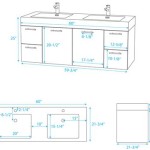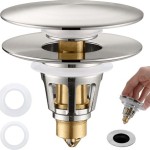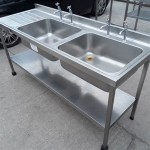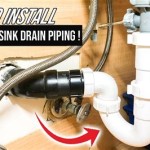How To Naturally Unclog a Sink
A clogged sink is a common household problem that can disrupt daily routines. Blockages typically occur due to the accumulation of hair, soap scum, grease, food particles, and mineral deposits within the drainpipe. While chemical drain cleaners offer a seemingly quick solution, they often contain harsh chemicals that can damage pipes, pose environmental risks, and present health hazards. Consequently, exploring natural and safer methods to unclog a sink is advantageous.
The following article details several effective, natural techniques for resolving sink clogs, emphasizing the use of readily available household items and simple tools. These methods range from simple flushing techniques to more involved procedures, aiming to provide a comprehensive guide for homeowners and renters facing this plumbing issue.
Boiling Water Flush
Boiling water is often the first and simplest approach to try when dealing with a clogged sink. This method works best for clogs caused by grease, soap scum, or other substances that melt or dissolve under high temperatures. The principle is straightforward: the hot water loosens the blockage and flushes it down the drain.
To implement this method, bring a kettle or pot of water to a rolling boil. Carefully pour the boiling water directly down the drain. It is crucial to exercise caution during this step to avoid burns. Allow the hot water to sit for a few minutes to work on the clog. After a short wait, turn on the faucet to see if the water drains freely. If the sink remains clogged, repeat the process one or two more times. For persistent clogs, consider using one of the alternative methods described below.
It is also important to note that boiling water should not be used on PVC pipes, as the high temperature can potentially warp or damage them. If the plumbing system incorporates PVC pipes, opt for hot tap water instead. While less effective than boiling water, it still provides some degree of heat to help loosen the clog.
Furthermore, this method is most effective when the blockage is relatively minor and located close to the drain opening. Deeper or more substantial clogs may require more aggressive techniques.
Baking Soda and Vinegar Solution
A baking soda and vinegar solution provides a natural chemical reaction that can effectively dissolve many types of sink clogs. This method leverages the alkaline properties of baking soda (sodium bicarbonate) and the acidic properties of vinegar (acetic acid) to create a fizzing action that helps to break down the blockage.
To utilize this method, first remove any standing water from the sink. Pour approximately one cup of baking soda down the drain, ensuring it goes directly into the drainpipe. Follow with one cup of white vinegar. A fizzing reaction will immediately occur. Let the mixture sit for at least 30 minutes, or preferably overnight, to allow the reaction to fully dissolve the clog.
After the waiting period, flush the drain with hot water. The force of the water, combined with the dissolved clog, should clear the pipe. If the sink remains clogged, repeat the process one or two more times. For particularly stubborn clogs, consider using a plunger after the baking soda and vinegar treatment to physically dislodge the blockage.
The effectiveness of this method relies on the chemical reaction between the baking soda and vinegar. The carbon dioxide gas produced during the reaction helps to agitate the clog, while the mild acidity of the vinegar helps to break down organic matter. While this method is generally safe for most plumbing systems, it is important to avoid prolonged or excessive use, as the acidity of vinegar can, over time, corrode certain types of pipes.
Additionally, ensure adequate ventilation during this process, as the fizzing reaction can release a strong odor. Opening a window or turning on a bathroom fan can help to dissipate the smell.
Plunger Application
A plunger is a simple yet effective tool for creating suction and pressure to dislodge sink clogs. Plungers come in two primary types: cup plungers and flange plungers. Cup plungers are best suited for flat surfaces, such as sinks and bathtubs, while flange plungers have a soft rubber flap that folds out to form a seal around toilet drains.
To use a plunger effectively on a sink, ensure there is enough water in the sink to cover the cup of the plunger. This helps create a tight seal, which is essential for generating suction. If the sink is a double basin, plug the other drain opening with a wet cloth to prevent air from escaping and compromising the suction.
Place the cup of the plunger directly over the drain opening, ensuring a firm seal. Push and pull the plunger up and down vigorously, maintaining the seal throughout the process. Continue plunging for several minutes, or until the water begins to drain freely. It is important to use a consistent, rhythmic motion to maximize the effectiveness of the plunger.
If the sink remains clogged after several minutes of plunging, remove the plunger and check the drain opening for any visible debris. Remove any visible debris, and then repeat the plunging process. For particularly stubborn clogs, it may be necessary to alternate between plunging and flushing the drain with hot water.
The plunger works by creating alternating pressure and suction within the drainpipe. The pressure forces the clog further down the pipe, while the suction attempts to pull it back up. This repeated action can eventually break up the clog or dislodge it completely.
It's also crucial to select the correct size of plunger for the drain opening. A plunger that is too small will not create a proper seal, while a plunger that is too large may be difficult to maneuver. Ensure the plunger is in good condition, with a flexible cup that is free of cracks or tears. A damaged plunger will not create an effective seal.
Bent Wire or Drain Snake Utilization
When simpler methods fail, a bent wire or drain snake can be employed to physically remove the clog. These tools allow for direct access to the drainpipe and can break up or pull out blockages that are located deeper within the plumbing system.
A bent wire can be fashioned from a wire coat hanger or a similar piece of sturdy wire. Straighten the wire as much as possible, then bend one end into a small hook. Carefully insert the hooked end of the wire down the drain opening. Rotate and maneuver the wire to feel for the clog. Once the clog is located, attempt to break it up or pull it out. Be cautious not to push the clog further down the drainpipe.
Periodically remove the wire to clean off any debris that has been collected. Repeat the process until the drain flows freely. It is important to exercise caution when using a bent wire to avoid scratching or damaging the inside of the drainpipe. Work slowly and deliberately to avoid forcing the wire, which could potentially cause it to break off inside the pipe.
A drain snake, also known as a plumbing snake or auger, is a more specialized tool designed for removing clogs from drains. Drain snakes typically consist of a long, flexible metal cable with a corkscrew or auger end. These tools are available in various lengths and diameters, allowing for access to different parts of the plumbing system.
To use a drain snake, carefully insert the end of the cable down the drain opening. Rotate the handle of the snake to feed the cable further down the drainpipe. Continue feeding the cable until resistance is felt, indicating the presence of a clog. Once the clog is located, rotate the handle to engage the auger end and break up or retrieve the blockage.
Periodically retract the snake to clean off any debris. Repeat the process until the drain flows freely. Drain snakes are more effective than bent wires for removing stubborn or deep-seated clogs. However, they also require more skill and caution to use. Avoid forcing the snake, which could damage the pipes. Wear gloves to protect your hands from dirt and debris.
After using either a bent wire or a drain snake, it is advisable to flush the drain with hot water to remove any remaining debris. This helps ensure that the drain is completely clear and will prevent future clogs.
Disassembling and Cleaning the P-Trap
When simpler methods fail to resolve a sink clog, disassembling and cleaning the P-trap may be necessary. The P-trap is a curved section of pipe located beneath the sink. Its primary function is to trap debris and prevent sewer gases from entering the home. However, the P-trap can also become a common location for clogs.
Before disassembling the P-trap, place a bucket or container beneath the drainpipe to catch any water or debris that may spill out. Loosen the slip nuts that connect the P-trap to the drainpipe and tailpiece. These nuts are typically hand-tightened, but may require the use of pliers if they are stuck.
Once the slip nuts are loosened, carefully remove the P-trap. Empty the contents of the P-trap into the bucket. Inspect the P-trap for any visible debris or clogs. Remove any debris by hand or with a small tool. Rinse the P-trap thoroughly with water to remove any remaining residue.
Inspect the drainpipe and tailpiece for any clogs as well. Use a bent wire or drain snake to remove any blockages from these pipes. Once all components are clean, reassemble the P-trap. Ensure that the slip nuts are tightened securely, but not overtightened, to prevent leaks.
After reassembling the P-trap, turn on the faucet to check for leaks. If any leaks are detected, tighten the slip nuts further. If the leaks persist, disassemble the P-trap again and inspect the slip nuts and washers for damage. Replace any damaged parts as needed.
Disassembling and cleaning the P-trap can be a messy process, so it is important to wear gloves and protective eyewear. Take your time and work carefully to avoid damaging the pipes or fittings. If you are uncomfortable disassembling the P-trap yourself, consider hiring a plumber.
This method is particularly effective for removing clogs that are caused by a buildup of solid debris, such as hair, food particles, or small objects. By physically removing the clog, this method provides a more thorough and long-lasting solution than some of the other approaches.

How To Unclog A Sink The Experts Simple Steps Drain

How To Naturally Clean A Clogged Drain The Definitive Guide Bren Did

How To Unclog A Kitchen Sink Using Baking Soda And Vinegar

Unclogging Plugged Sinks Homemade Drain Cleaner More

5 Natural Ways To Unclog A Bathroom Sink Hiller How

How To Clean Drains With Baking Soda And Vinegar Liquid Plumr

Easy Ways To Unclog Drains Clearing Clogged

How To Unclog A Sink The Right Way

How To Unclog Drain 7 Easy Ways Super Quickly

Unclog Drain







